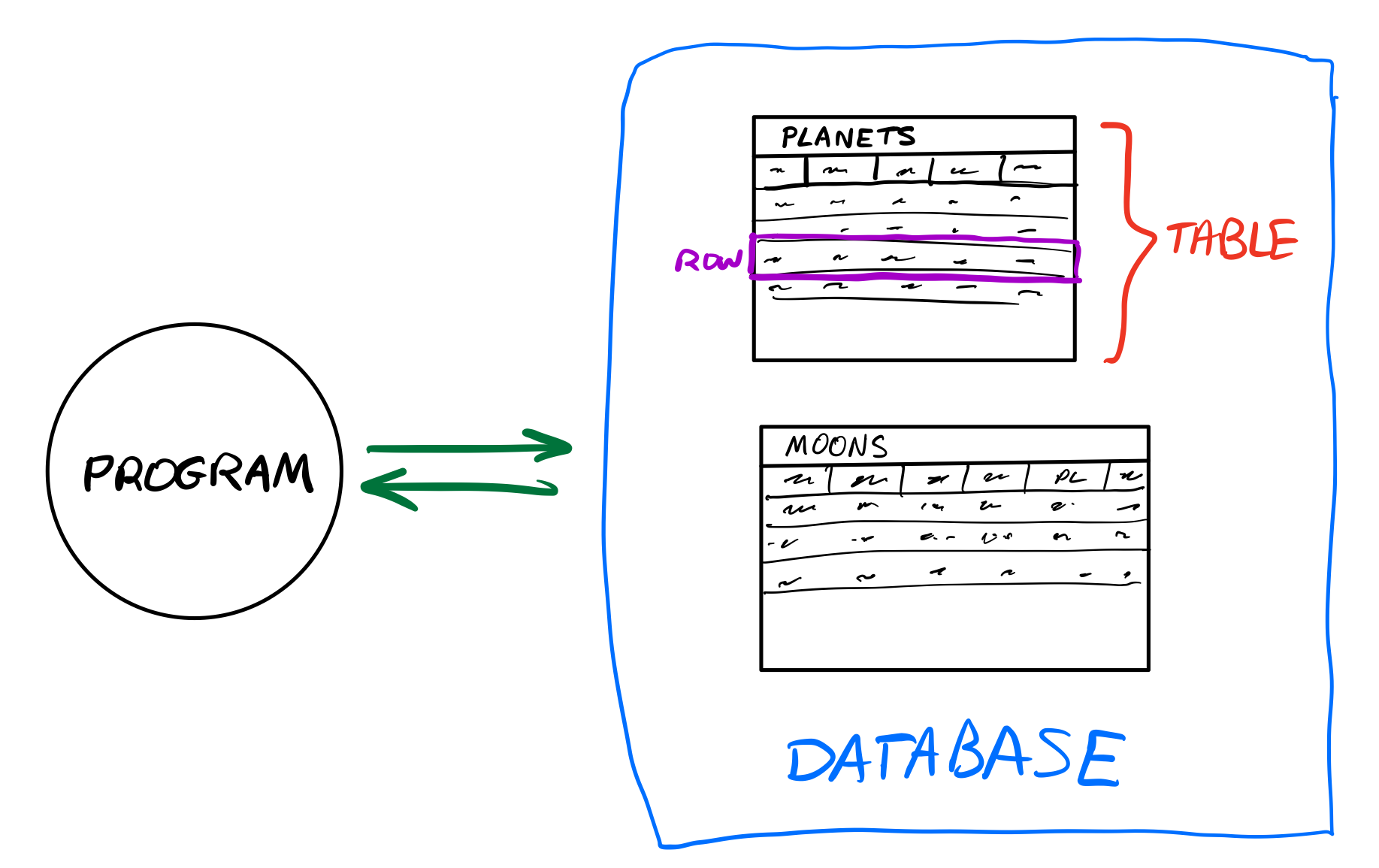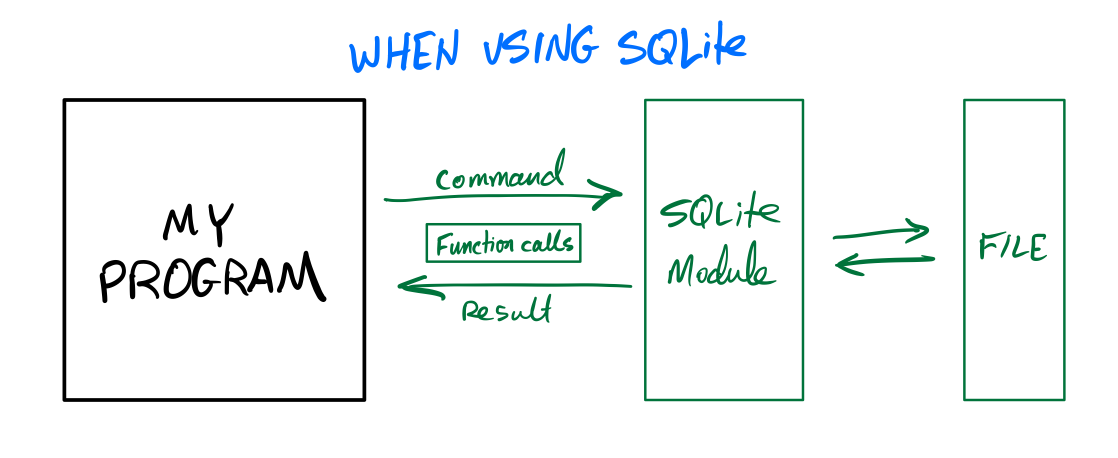Lecture 30
SQL and SQLite
MCS 275 Spring 2022
Emily Dumas
Database
A database is a storage and retrieval system for structured data, usually in a persistent storage medium.
Usually this term is used when the system offers a rich command language.
We'll only cover relational databases, which are based on collections of tables.

Typical relational DB features
- Add, delete or modify tables
- Find and return rows of a table meeting given criteria
- Add or update data
DB commands usually express intent (find and remove all rows with this property...), whereas file IO modules operate at a lower level (get the next line of text, ...) requiring you to build the required operations.
Application structure


SQLite
SQLite is an open source relational database that stores an entire database in a single file.
It uses the same command language as many other popular databases: The Structured Query Language, or SQL.
It consists of a standalone program where you can run database commands in a REPL environment, as well as libraries for most popular programming languages.
SQLite command line shell installation
- Windows — Download the "sqlite-tools" zip file for windows from the sqlite download page. Extract it to get "sqlite.exe". Put it somewhere you can find in the terminal and run it from powershell.
- MacOS — You already have it as
/usr/bin/sqlite3. You can probably just typesqlite3in a terminal. - Linux — You may already have it (try
sqlite3in a terminal), otherwise use your package manager to install. In Ubuntu that package is calledsqlite3.
SQLite command line shell
Then you use it as one of:
sqlite3 DBFILENAME
sqlite3.exe DBFILENAMEIf the file exists, it is opened in the SQLite REPL.
If it does not exist, it is created and opened in the SQLite REPL.
SQLite hello world
Let's write a Python program to make SQLite database, add one table to it, add a couple of rows of data to the table, then read them back.
Connecting to a database
In sqlite3, opening a "connection" means opening or creating a database file.
import sqlite3
con = sqlite3.connect("solarsystem.sqlite") # .db also popular
con.execute( ...sql_statement_goes_here... )
con.commit() # Save any changes to disk
con.close() # Close the database file
CREATE TABLE
CREATE TABLE planets (
name TEXT,
dist REAL,
year_discovered INTEGER
);
Each item in parentheses is column_name COLUMN_TYPE.
INSERT
The INSERT command adds a row to a table.
To pass values to a statement in execute(), use ? characters as placeholders and then give a tuple of values in the second argument.
con.execute(
"INSERT INTO planets VALUES (?,?,?);",
("Earth", 1.0, None)
)
Similar for ("Neptune", 30.1, 1846).
Planets
| Name | Distance from sun | Year discovered |
|---|---|---|
| (AU) | ||
| Mercury | 0.4 | ? |
| Venus | 0.7 | ? |
| Earth | 1 | ? |
| Mars | 1.5 | ? |
| Jupiter | 5.2 | ? |
| Saturn | 9.5 | ? |
| Uranus | 19.2 | 1781 |
| Neptune | 30.1 | 1846 |
Placeholder gotcha
When calling execute() with placeholders in the SQL statement, the second argument MUST be an iterable of values.
So if you have only one value, you need to wrap it in a list or tuple.
con.execute("INSERT INTO tab VALUES (?);", 275) # FAILS
con.execute("INSERT INTO tab VALUES (?);", [275] ) # OK
con.execute("INSERT INTO tab VALUES (?);", (275,) ) # OK
These examples assume tab is a table with just one column.
SELECT
Find and return rows. The most common query!
SELECT * FROM table_name; -- give me everything
SELECT * FROM table_name WHERE condition; -- some rows
SELECT col3, col1 FROM table_name; -- some columns
SELECT * FROM table_name LIMIT 10; -- at most 10 rows
SELECT * FROM table_name
ORDER BY col2; -- sort by col2, smallest first
SELECT * FROM table_name
ORDER BY col2 DESC; -- sort by col2, biggest first
SELECT DISTINCT ... ; -- no repeat answers
SQL conditions
Examples of things that can appear after WHERE:
col = value -- Also supports >, >=, <, <=, !=
col IN (val1, val2, val3)
col BETWEEN lowval AND highval
col IS NULL
col IS NOT NULL
stringcol LIKE pattern -- string pattern matching
condition1 AND condition2
condition1 OR condition2
LIKE
coursetitle LIKE "Introduction to %"
itemtype LIKE "electrical adapt_r"
In a pattern string:
%matches any number of characters (including 0)_matches any single character
e.g. "%d_g" matches "fossil dig" and "dog" but does not match "hypersonic drag", "dog toy", or "dg".
WOBL
WHERE, ORDER BY, LIMIT can be used together, but must appear in that "WOBL" order. (Details.)
UPDATE
Change values in a row (or rows).
UPDATE table_name SET col1=val1, col5=val5 WHERE condition;
Warning: Every row meeting the condition is changed!
Also supports ORDER BY and LIMIT.
DELETE
Remove rows matching a condition.
DELETE FROM table_name WHERE condition;
Also supports ORDER BY and LIMIT (e.g. to remove n rows with largest values in a given column).
Immediate, irreversible. Also, an empty table isn't the same thing as a deleted table.
DROP TABLE
Deletes an entire table.
DROP TABLE table_name; -- no such table = ERROR
DROP TABLE IF EXISTS table_name; -- no such table = ok
Immediate, irreversible.
Initial state
SQLite creates the database file if it doesn't exist, but with no tables in it.
Most programs will need to contain code to set up the necessary tables if they do not already exist.
References
- SQLite home page
- sqlitetutorial.net has a nice tutorial where you can run SQL command directly in your browser. Their SQLite install instructions are detailed and easy to follow, too.
- Intro to Python for Computer Science and Data Science by Deitel and Deitel, Section 17.2. (This is an O'Reilly book, free for anyone with a UIC email; see course page for login details.)
- Computer Science: An Overview by Brookshear and Brylow, Chapter 9.
Revision history
- 2022-03-28 Initial publication
- 2022-04-15 Add note about single placeholder execute gotcha